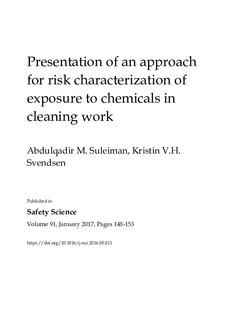| dc.contributor.author | Suleiman, Abdulqadir M. | |
| dc.contributor.author | Svendsen, Kristin V Hirsch | |
| dc.date.accessioned | 2018-04-17T12:50:21Z | |
| dc.date.available | 2018-04-17T12:50:21Z | |
| dc.date.created | 2017-07-30T13:36:34Z | |
| dc.date.issued | 2017 | |
| dc.identifier.citation | Safety Science. 2017, 91 148-153. | nb_NO |
| dc.identifier.issn | 0925-7535 | |
| dc.identifier.uri | http://hdl.handle.net/11250/2494515 | |
| dc.description.abstract | Background
Workplace risk assessment methods require expertise which cleaning companies may lack.
Objective
To present a methodological, easy-to-implement approach for risk characterisation of cleaning work, and elaborate on its applicability.
Materials and method
Determinants of chemical exposure including, inter alia, frequency of use (ν), use of PPE (θ) and spray bottle (σ), dilution of chemicals (δ), and workplace ambience (ξ) are used to characterise risk of cleaning work. These, are assigned numerical factors according to how they manifest in work situations. The conceptualised assessment factor, presented as ω = ν∗θ∗δ∗σ∗ξ is used to formulate work risk factor, ∑RF. Calculating ∑RF for workplaces with many cleaning workers and work patterns, agreement on how tasks are performed, use of PPE and spray bottles among minimum 60% of participants was set as acceptance criteria for uniformity of workplace trend. Risk characterisation ratio (RCR) used to compare cleaning work is obtained by collating actual ∑RF to a hypothetical minimum exposure ideal ∑RF.
Results
Assessing different work situations, cleaning Shopping Centre gave the lowest RCR = 1.65, whereas travel terminals had the highest RCR = 7.41. Offices, hospital and kindergarten cleaning gave RCR = 4.05, 4.47 and 4.82 respectively. From RCRs, the largest disparity was between shopping centre and terminals; the least was between office and hospital, and similarly between hospital and kindergartens cleaning.
Conclusion
The approach enables evaluation of work situation establishing the risk of exposure to chemicals. Use of determinants of exposure makes the approach a versatile tool for determination of risk of exposure. | nb_NO |
| dc.language.iso | eng | nb_NO |
| dc.publisher | Elsevier | nb_NO |
| dc.rights | Attribution-NonCommercial-NoDerivatives 4.0 Internasjonal | * |
| dc.rights.uri | http://creativecommons.org/licenses/by-nc-nd/4.0/deed.no | * |
| dc.title | Presentation of an approach for risk characterization of exposure to chemicals in cleaning work | nb_NO |
| dc.type | Journal article | nb_NO |
| dc.type | Peer reviewed | nb_NO |
| dc.description.version | acceptedVersion | nb_NO |
| dc.source.pagenumber | 148-153 | nb_NO |
| dc.source.volume | 91 | nb_NO |
| dc.source.journal | Safety Science | nb_NO |
| dc.identifier.doi | 10.1016/j.ssci.2016.08.011 | |
| dc.identifier.cristin | 1483389 | |
| dc.description.localcode | © 2016. This is the authors’ accepted and refereed manuscript to the article. Locked until 23.8.2019 due to copyright restrictions. This manuscript version is made available under the CC-BY-NC-ND 4.0 license http://creativecommons.org/licenses/by-nc-nd/4.0/ | nb_NO |
| cristin.unitcode | 194,60,25,0 | |
| cristin.unitname | Institutt for industriell økonomi og teknologiledelse | |
| cristin.ispublished | true | |
| cristin.fulltext | postprint | |
| cristin.qualitycode | 1 | |

